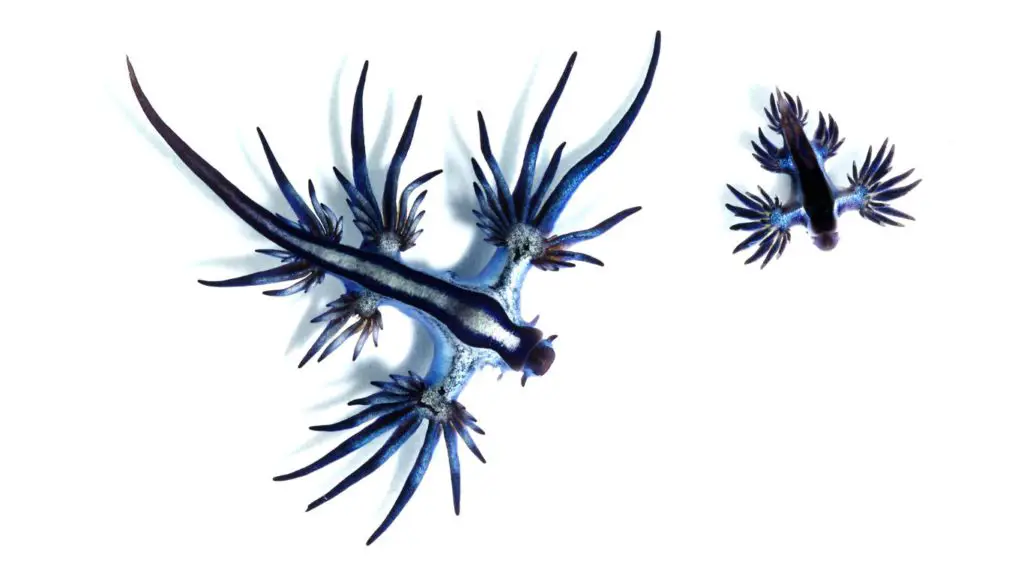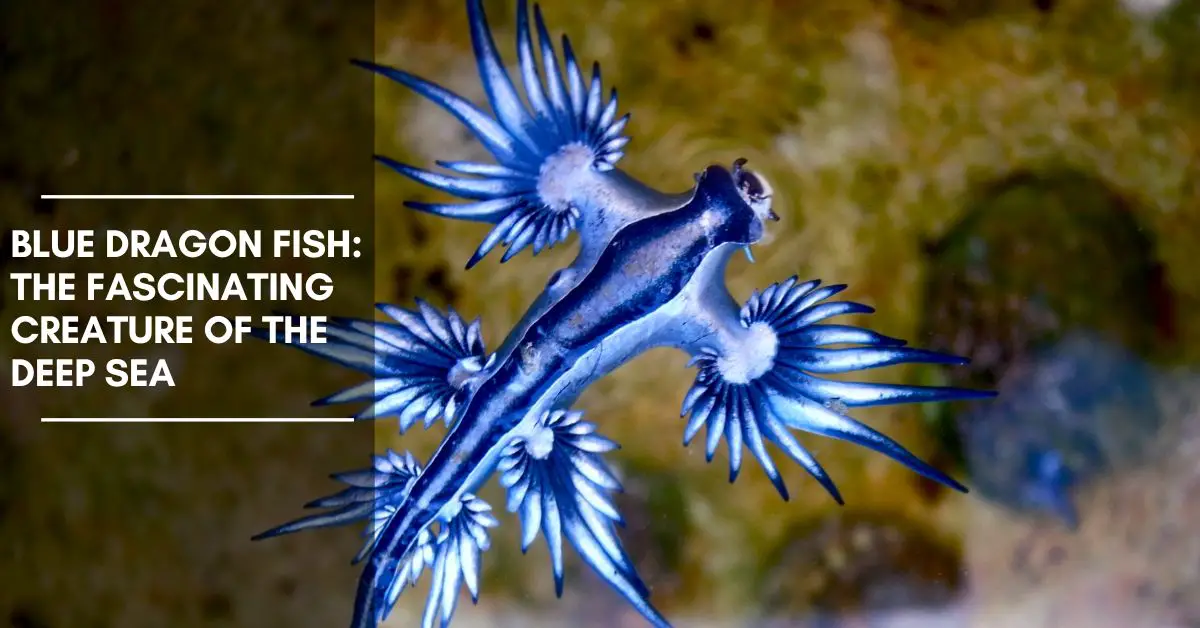The Blue Dragon Fish, which is also called the Blue Sea Slug, is a beautiful and unusual animal that lives in the deep ocean. With its beautiful blue color and complex body structure, this animal has caught the attention of marine biologists and ocean lovers alike.
Blue Dragon Fish is a species of nudibranch, which is a type of soft-bodied, marine gastropod mollusk that does not have a shell. It is also known as Glaucus Atlanticus, and it belongs to the family Glaucidae. This incredible creature is found in the deep waters of the Atlantic, Pacific, and Indian Oceans, and it is known for its striking blue color, which helps it camouflage in the water.
In this article, I will explore the world of the Blue Dragon Fish, its habitat, physical characteristics, behavior, and significance in the marine ecosystem.
Habitat of Blue Dragon Fish
The Blue Dragon Fish is a pelagic animal, which means it lives in the open ocean and drifts with the currents for most of its life. This species lives in warm water and can be found in the Mediterranean Sea, the Atlantic, Pacific, and Indian Oceans, and also in the Pacific Ocean. It lives in the Sargasso Sea, where it eats seaweed that floats on the water.
Physical Characteristics of Blue Dragon Fish
The Blue Dragon Fish is a small creature, typically measuring around 3 cm in length. It has a unique, flattened body shape, which is designed to help it float on the water’s surface.
Its body is covered in tiny, hair-like structures known as cilia, which help it move through the water. The Blue Dragon Fish has six appendages on its back, which resemble wings and give it its distinctive appearance. These wings are blue on the upper side and silver on the underside, which helps them camouflage in the water.
Tetra AquaSafe Plus, 8.45 Ounces, aquarium Water Conditioner And Dechlorinator, Model Number: 46798162681
15% OffAPI TAP WATER CONDITIONER Aquarium Water Conditioner 16-Ounce Bottle
(as of July 21, 2024 08:16 GMT +03:00 - More infoProduct prices and availability are accurate as of the date/time indicated and are subject to change. Any price and availability information displayed on [relevant Amazon Site(s), as applicable] at the time of purchase will apply to the purchase of this product.)API STRESS COAT Aquarium Water Conditioner 4-Ounce Bottle (85B)
40% OffDiet of Blue Dragon Fish
The Blue Dragon Fish is a carnivorous creature, and it feeds on a variety of small marine animals, including jellyfish, siphonophores, and other small creatures that float on the water’s surface. The Blue Dragon Fish has a unique feeding mechanism that allows it to consume its prey whole.
It feeds on its prey by using its sharp, beak-like mouthparts to puncture the prey’s body and inject a toxic substance that paralyzes it. The Blue Dragon Fish then consumes the prey whole, using its stomach to digest the food.

Reproduction and Lifecycle of Blue Dragon Fish
The Blue Dragon Fish is a hermaphrodite, which means it has both male and female reproductive organs. It has internal fertilization, and the female lays a cluster of eggs that are attached to a raft-like structure that floats on the water’s surface. The eggs turn into larvae, which then turn into Blue Dragon Fish as they grow up.
The Behavior of Blue Dragon Fish
The Blue Dragon Fish is a passive creature, and it spends most of its life drifting along with ocean currents. It is able to control its buoyancy by adjusting the amount of air it stores in its body, allowing it to float on the water’s surface or dive deeper into the water.
The Blue Dragon Fish is also known for its ability to create its own venom, which it uses as a defense mechanism against predators. When threatened, the Blue Dragon Fish can release its venom, which causes a painful sting and can be deadly to small animals.
Predators and Threats to Blue Dragon Fish
Even though it has a poisonous defense, the Blue Dragon Fish is eaten by larger fish, sea birds, and some types of sea turtles. The Blue Dragon Fish population is also threatened by things that people do, like polluting the water and catching too many of them.
In some parts of the world, the Blue Dragon Fish is taken because of how pretty it is and sold as a pet. This has caused the number of these fish to drop.
Significance of Blue Dragon Fish in the Marine Ecosystem
The Blue Dragon Fish plays an important role in the marine ecosystem as a predator of small marine animals, such as jellyfish, which can be harmful to other marine life if their population grows unchecked. The Blue Dragon Fish also serves as a food source for larger marine animals, such as sea birds and some species of sea turtles.
Conservation Efforts for Blue Dragon Fish
Conservation efforts for the Blue Dragon Fish are focused on protecting its natural habitat and reducing human activities that pose a threat to its population. Several organizations are working to raise awareness about the importance of preserving the Blue Dragon Fish’s population, and efforts are underway to create protected areas where this species can thrive.
Conclusion
The Blue Dragon Fish is a unique and fascinating creature that inhabits the deep waters of the ocean. Its stunning blue color and intricate body structure have captivated the attention of marine biologists and ocean enthusiasts alike. The Blue Dragon Fish plays an important role in the marine ecosystem, and efforts must be made to protect its population and preserve its natural habitat.
FAQs
- What is the Blue Dragon Fish? The Blue Dragon Fish is a species of nudibranch, which is a type of soft-bodied, marine gastropod mollusk that does not have a shell.
- Where is the Blue Dragon Fish found? The Blue Dragon Fish is found in the deep waters of the Atlantic, Pacific, and Indian Oceans, as well as the Mediterranean Sea.
- What does the Blue Dragon Fish eat? The Blue Dragon Fish is a carnivorous creature and feeds on a variety of small marine animals, including jellyfish and siphonophores.
- Is the Blue Dragon Fish venomous? Yes, the Blue Dragon Fish is venomous and can release its venom as a defense mechanism against predators.
- Are there conservation efforts for the Blue Dragon Fish? Yes, several organizations are working to raise awareness about the importance of preserving the Blue Dragon Fish’s population, and efforts are underway to create protected areas where this species can thrive.

Hi, my name is Sean, and I’m the primary writer on the site. I’m blogging mostly about freshwater and saltwater aquariums, fish, invertebrates, and plants. I’m experienced in the fishkeeping hobby for many years. Over the years I have kept many tanks, and have recently begun getting more serious in wanting to become a professional aquarist. All my knowledge comes from experience and reading forums and a lot of informative sites. In pursuit of becoming a professional, I also want to inspire as many people as I can to pick up this hobby and keep the public interest growing.
Read more about Sean.
Please join also my Facebook group.



















